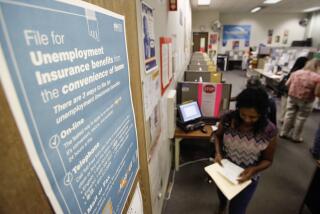For many, being jobless can seem never-ending
- Share via
Reporting from Washington — Despite optimism over recent job gains, one grim statistic casts a long shadow over the recovering economy -- a record 44% of the nation’s 15 million unemployed have been out of work for more than six months.
And the evidence suggests that many of them may never completely rebuild the working lives they lost.
Never since the Great Depression has the U.S. labor market seen anything like it. The previous high in long-term unemployment was 26% in June 1983, just after the deep downturn of the early 1980s. The 44% rate in March translates into more than 6.5 million people.
In fact, nearly two-thirds of these workers have been jobless for a year or longer, new Labor Department reports show.
On Wednesday, Federal Reserve Chairman Ben S. Bernanke told the congressional Joint Economic Committee that he was “particularly concerned” about the huge number of long-term unemployed.
“Long periods without work erode individuals’ skills and hurt future employment prospects,” he said. “Younger workers may be particularly adversely affected if a weak labor market prevents them from finding a first job or from gaining important work experience.”
Bernanke also reiterated his recent comments that the economy is in the midst of a “moderate” recovery from the recession and that the country needs to address soaring budget deficits. The Fed also expects that its near-zero interest rate policy will continue for an extended period.
The efforts to resuscitate the economy as well as the hardships of unemployed workers are straining the nation’s finances too. In normal times, jobless workers can qualify for up to 26 weeks of state unemployment benefits. But the severe economic crisis in the last two years has prompted Washington to help fund jobless benefits for up to 99 weeks in high-unemployment states, including California and Florida.
Federal spending on unemployment benefits could reach $168 billion this year, five times the level in the years just before the recession, according to a report by Pew Charitable Trusts. In addition, tens of billions of dollars more are being spent on food assistance for unemployed workers and their families.
At the same time, government revenues have fallen as Social Security, payroll and other tax receipts have shriveled with fewer jobs and lower earnings. That has contributed to massive fiscal problems in many states.
California, which is expected to report the latest jobless figures for the state Friday, already owes the federal government about $7 billion for unemployment benefit loans and is getting deeper in the hole by the week.
“It’s really killing efforts to rein in the deficit,” said David Card, an economics professor at UC Berkeley, which has made cuts in faculty pay and course selections.
The rise in long-term unemployment -- coupled with economists’ projections of a slow recovery in the job market -- means the toll to individual and government budgets is likely to persist for some time. Labor Department figures suggest there are 5.5 unemployed workers today for each job opening, compared with two job seekers for every opening in 2007.
And the seriousness of the problem is magnified by the enormous scale of job loss during the recession, in which more than 8 million jobs were cut -- on top of the roughly 7 million people who were jobless before it began in 2007.
The economy needs to create about 125,000 jobs a month just to keep pace with the population growth, and the recovery isn’t expected this year to produce anywhere near the several hundred thousand jobs that are needed monthly to make a significant dent in the unemployment rate, currently at 9.7%.
As for the kinds of long-term jobs being created, government data show a smattering of gains all across the spectrum -- from minimum-wage to high-income.
But there is no sign yet of a surge in the kinds of stable, above-average-income jobs that have been the backbone of the nation’s prosperity in the past. Healthcare and temporary jobs have been leading the pack, but many of the jobs come with relatively modest wages.
The problem has another, less direct effect as well: Because many of the long-term unemployed are older workers, some have little choice but to retire earlier than planned. That means more people will be drawing Social Security and Medicare, and fewer will be contributing to those programs through payroll taxes.
As in previous downturns, a large share of the long-term unemployed are in manufacturing and construction.
But most of today’s workers who have been jobless for 27 weeks or more are in sales, office and other service industry jobs, including more than 1 million in management and professional occupations.
Some economists doubt that workers in general would lose skills after just six months or even a year or two out of work.
But there is widespread agreement that, for whatever reasons, long periods of unemployment tend to make it tougher to get reemployed.
And even after getting hired, such workers will probably experience a sharp and lasting hit to their incomes.
In one prominent study, Columbia University economist Till von Wachter examined the pay history of workers who lost their jobs during the early 1980s recession. Using Social Security earnings records, Von Wachter and co-researchers found that these previously stable workers who lost their jobs but found new ones later were earning 20% less a decade later than other workers who weren’t let go during that period.
For the laid-off group, the income losses didn’t fade away completely even 20 years later.
Jim Sullivan, a Philadelphia-area resident, had his best earnings ever in 2008. He made $140,000 as director of operations for a small landscape supply firm. But sales plunged last year, and in June he was one of a dozen employees laid off.
“I’ve sent out probably in excess of 3,000 resumes and had a grand total of two telephone interviews,” said the 52-year-old, whose longest bout of unemployment before was three weeks in the early 1980s soon after college.
Lately Sullivan has seen more postings on job boards and feels a little more optimistic about the future. But he’s not counting on pulling down a six-figure income any time soon.
“I’d be tickled to death to take 40% of that right now,” he said. That works out to $56,000.
Sullivan, a single father of a 13-year-old girl, has been drawing unemployment benefits of $558 a week, before taxes. But that hasn’t been enough to cover his mortgage and other bills. He has gone through most of his savings and is contemplating selling his house, which he has owned for 15 years. He doesn’t want to move far and uproot his daughter.
For some workers, upside-down mortgages and an inability to sell their homes have restricted mobility, prolonging their joblessness. For others like Sullivan, age adds another barrier to a group that already may face a stigma, having been out of work for a long stretch.
This so-called scarring effect may not be so bad today given the huge numbers of long-term unemployed. Still, it’s especially hard for older workers, and 4 out of 10 of those out of work for more than six months are 45 or older.
Rola Cook of Molalla, Ore., south of Portland, had planned to work until he hit 66. But the recession changed everything. Two years ago, he was laid off from his sales job at a paint company, and he has been drawing unemployment benefits ever since.
Next month Cook will turn 62. Unless something pops up, he plans to start collecting Social Security.
With two years of college, Cook has bounced from one job to another in the last decade. But his wife still works at a local lumber company. And the couple has a solid financial cushion from years of smart property investments and plain vanilla savings -- individual retirement accounts and certificates of deposit.
“My wife and I have always been quite frugal,” he said, noting that their grocery bills amount to just $30 a week.
At the other end of the career curve are young workers, including recent college graduates, many of whom have been kept on the sidelines, missing out on valuable job experience that’s needed to build their careers.
As each day of unemployment goes by, some of the long-term jobless worry that employers will look at them as damaged goods, wondering what’s wrong with them that they have been unemployed for so long.
Cook actually worries more about them than about himself.
“I’m not feeling good about not working,” he said. “What I’m concerned about is all these kids going to college. I don’t know where they’re going to go to work.”
More to Read
Inside the business of entertainment
The Wide Shot brings you news, analysis and insights on everything from streaming wars to production — and what it all means for the future.
You may occasionally receive promotional content from the Los Angeles Times.











